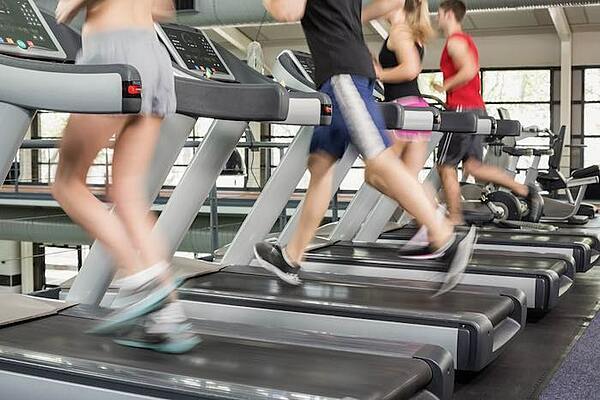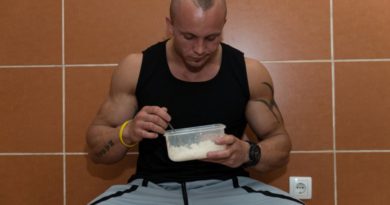Demolish Fat Cells With This HIIT Workout
If you want to get the most fat-burning benefits out of your time in the gym but hate traditional cardio, you’re in the right place. You may fall in love with a HIIT workout, even ones you can do at home.
In my years as a certified personal trainer and sports nutritionist, I’ve seen countless people slog away on treadmills, secretly hating every minute.
Let’s be honest, steady-state cardio can be boring.
What if you could get better results in a fraction of the time? That’s the power of a High-Intensity Interval Training (HIIT) workout. This guide breaks down exactly how to use HIIT to demolish fat cells, preserve muscle, and completely change the way you think about cardio.
Disclaimer: This article is for informational purposes only and is not meant to treat or diagnose any condition. It is recommended that you speak with your doctor before starting any exercise program, changing your daily nutrition, or adding any supplements to your regimen.
Table of contents
Key Takeaways
- Maximum Efficiency: A HIIT workout delivers superior fat-burning and cardiovascular benefits in sessions as short as 15-20 minutes, making it perfect for busy schedules.
- Metabolic Boost: HIIT triggers a powerful “afterburn effect” known as EPOC, causing your body to burn extra calories for up to 24-48 hours after your workout is finished.
- Preserves Muscle: Unlike long-duration cardio which can lead to muscle loss, the short, intense bursts of a HIIT workout help preserve your hard-earned lean muscle mass.
- Versatile and Accessible: You can do a HIIT workout anywhere with minimal to no equipment by using bodyweight exercises or simple tools like jump ropes.

What is HIIT?
A HIIT workout, or High-Intensity Interval Training, is a form of exercise where you push yourself to 100% maximum effort in short, intense bursts, followed by brief recovery periods. The goal is to elevate your heart rate to 80-95% of its maximum, a key factor that makes it so effective.
Instead of a 45-minute jog at a steady pace, a HIIT session might involve a 30-second all-out sprint followed by 60 seconds of walking for recovery. You repeat this cycle for just 15-20 minutes to burn more calories than you would in much longer steady-state sessions.
The real magic of HIIT is its effect on your metabolism, a phenomenon called Excess Post-exercise Oxygen Consumption (EPOC). Think of this as an “afterburn.” Because of the extreme intensity, your body has to work hard to recover and return to its normal resting state. This recovery process consumes extra oxygen and burns additional calories for hours after you’ve finished exercising. According to the Cleveland Clinic, this can increase your overall calorie burn from the workout by 6% to 15%.
But you have to be honest with your effort. To get the full benefits, you must push to your near-maximal effort during the intense phases. Coasting through the work periods will only cheat you out of the incredible results and benefits.
Why Should You Consider Utilizing a HIIT Workout?
You should use a HIIT workout because it is one of the most effective and time-efficient strategies for improving your body composition and overall health. Compare the physique of a sprinter to a marathon runner. The sprinter is typically more muscular and defined, which is a direct result of the type of explosive, anaerobic training that HIIT mimics.
The science-backed benefits go far beyond just saving time.
- Superior Fat Loss: A comprehensive review in the *British Journal of Sports Medicine* analyzed 36 studies and found that while both HIIT and moderate-intensity exercise reduce body fat, HIIT was more effective at reducing total absolute fat mass.
- Improved Heart Health: Studies show HIIT is incredibly effective at improving cardiovascular health. It can lower both your resting heart rate and blood pressure, with some research suggesting it’s even more effective than moderate-intensity exercise for this purpose.
- Boosts VO2 Max: VO2 max is the maximum amount of oxygen your body can use during intense exercise, and it’s a key indicator of fitness. Research consistently shows that high-intensity training is superior to moderate training for boosting VO2 max, with one study showing an improvement of over 7%.
- No Fancy Equipment Needed: You don’t need a gym membership. An effective HIIT workout can be done at home, in a park, or in a hotel room using just your body weight.
- Enhanced Brain Function: A 2024 study published in *Aging and Disease* found that six months of high-intensity training was enough to boost cognitive function, with the positive effects lasting for five years.
- Better Blood Sugar Control: HIIT can significantly improve insulin sensitivity, which helps your body manage blood sugar more effectively. This is a huge benefit for reducing the risk of type 2 diabetes.
Research consistently backs up the power of a good HIIT workout. A landmark study cited in the *Journal of Applied Physiology* found that after just two weeks of HIIT, participants increased their fat oxidation (the body’s ability to burn fat for fuel) by 30%. The evidence is clear: if your goal is to burn fat while preserving muscle, HIIT should be a core part of your program.
*Note: Any form of exercise comes with some inherent risk. An intense program such as a HIIT workout can have negative side effects if you have health issues known or unknown. It would be wise to consult with your doctor to ensure you are healthy enough before engaging in any workout program, including the one found below.
15-Minute HIIT Workout
This 15-minute HIIT workout is designed for maximum impact with a simple sprint, jog, and walk structure. It’s perfect for a treadmill or for taking outdoors on flat terrain. The goal is to keep your heart rate high to burn calories and improve your cardiovascular fitness.
Always start with a five-minute walk to get your blood pumping and warm up your muscles. This is crucial for preventing injury and preparing your body for the intensity to come.
After your warm-up, move directly into the circuit below. Complete the full five-minute circuit, then repeat it two more times for a total of 15 minutes of high-intensity work.
| Exercise | Duration | Intensity (1-10 Scale) |
|---|---|---|
| Sprint | 30 seconds | 9/10 (All-Out Effort) |
| Jog | 3 minutes | 5/10 (Conversation Pace) |
| Sprint | 30 seconds | 9/10 (All-Out Effort) |
| Walk | 1 minute | 3/10 (Active Recovery) |
| Repeat 2 more times (or more if desired) | ||
Try These HIIT Workout Variations
To keep your body guessing and prevent boredom, try swapping in different HIIT protocols. Here are a couple of my favorites:
- Tabata Protocol: Developed by Dr. Izumi Tabata, this is one of the most famous (and toughest) HIIT styles. It consists of 20 seconds of ultra-intense exercise followed by 10 seconds of rest, repeated for eight cycles. A full Tabata is only four minutes long, but it will be one of the longest four minutes of your life. You can use this protocol with exercises like burpees, kettlebell swings, or stationary bike sprints.
- Bodyweight Circuit: No equipment? No problem. Create a circuit of 4-5 bodyweight exercises. Perform each for 45 seconds with 15 seconds of rest in between. Once you complete the last exercise, rest for 60 seconds and repeat the entire circuit 3-4 times.
For instance, try the four exercises below for your bodyweight circuit:
- Jump Squats
- Push-Ups
- Mountain Climbers
- High Knees
Once you finish your 15-minute HIIT workout, cool down with a 5-minute walk to let your heart rate come down gradually. Great job, you’ve just completed an incredibly effective fat-burning session!
FAQs About HIIT
How often should I do a HIIT workout?
Because of its intensity, your body needs time to recover. The general recommendation from organizations like the American College of Sports Medicine (ACSM) is to perform HIIT 2-3 times per week on non-consecutive days. More than 40 minutes per week at over 90% max heart rate can lead to overtraining and diminished results.
Can beginners do HIIT?
Absolutely, but it’s crucial to start smart. If you’re new to exercise, the ACSM suggests building a base fitness level first, which means being able to handle 20-60 minutes of steady cardio 3-5 times a week. A beginner can modify HIIT by starting with longer rest periods, shorter work intervals, and lower-impact exercises like power walking or stationary cycling.
What’s the difference between HIIT and LISS?
LISS stands for Low-Intensity Steady-State cardio, like a 45-minute jog at a consistent pace. HIIT involves short, all-out bursts of effort followed by recovery. While both burn calories, HIIT is more time-efficient and creates a larger EPOC or “afterburn” effect. LISS is less stressful on the joints and can be better for active recovery days.
Are there any apps you recommend for HIIT?
Yes, several apps are fantastic for guided HIIT workouts. Forbes Health rated apps like FitOn and Gymshark Training highly in 2025 for their variety. CNET also recommends the Nike Training Club app, which offers a huge library of free HIIT sessions led by top trainers.


*Disclosure: This article may contain affiliate links or ads, which means we earn a small commission at no extra cost to you if you make a purchase through these links. These commissions help support the operation and maintenance of our website, allowing us to continue producing free valuable content. Your support is genuinely appreciated, whether you choose to use our links or not. Thank you for being a part of our community and enjoying our content.
PLEASE CONSIDER SHARING THIS ON YOUR SOCIAL MEDIA TO HELP OTHERS LEARN MORE ABOUT THIS TOPIC.





